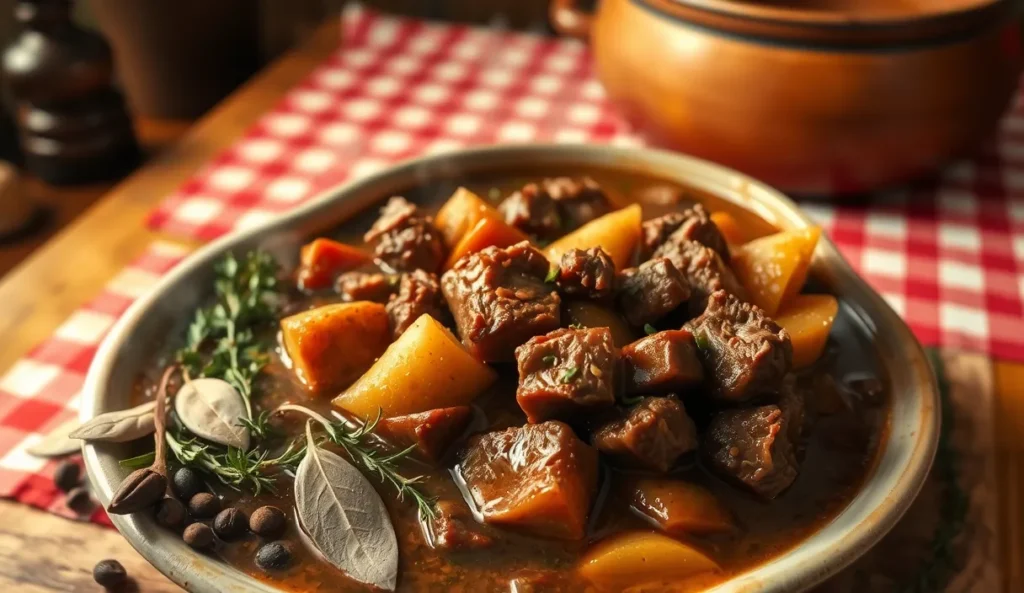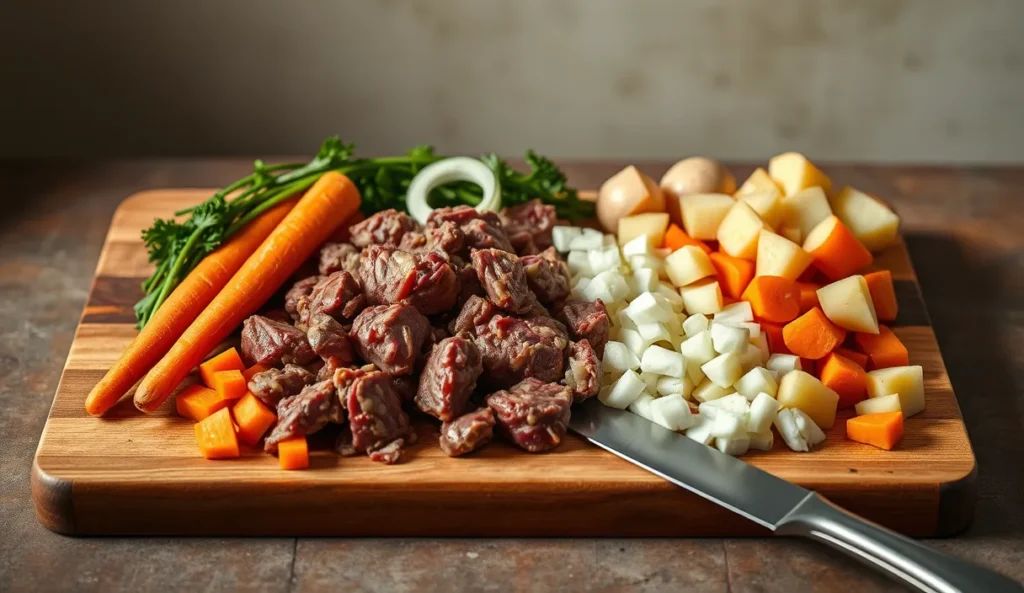Table of Contents
Welcome to the ultimate guide to local style beef stew. This dish is a quintessential American classic. It warms hearts and satisfies hunger across the country. It’s more than just a meal; it’s a culinary tradition passed down through generations.
Your journey into authentic American comfort food starts here. The local style beef stew captures the essence of home cooking. It blends tender meat, robust vegetables, and rich flavors that tell a story of regional culinary heritage.
From bustling city kitchens to rural farmhouse tables, this beloved dish unites Americans. Each spoonful brings memories of family gatherings and comfort during cold winter nights.
Key Takeaways
- Local style beef stew represents traditional American comfort food
- Recipe variations reflect regional culinary diversity
- Perfect for family meals and cold weather dining
- Nutritious and satisfying one-pot meal
- Connects generations through shared cooking traditions
Understanding the Rich Heritage of American Beef Stew

Beef stew is more than a meal in American cuisine. It’s a journey through the country’s diverse cultures. The history of American beef stew shows how immigrant traditions, regional creativity, and family ties come together through food.
The history of beef stew goes back to early colonial times. Settlers brought European cooking to the New World. Native American farming and European influences created this beloved American comfort food.
Origins and Cultural Significance
As different communities adapted, regional beef stew variations emerged. For example:
- New England made hearty, potato-rich versions
- Southern states added spicier seasonings
- Hawaiian-style beef stew included shoyu (soy sauce)
Family Recipe Evolution
Family beef stew recipes are treasured traditions. Each family made the dish their own, turning a simple meal into a personal expression.
Every beef stew tells a story of home, heritage, and shared memories.
Beef stew has stayed a favorite dish across America. It connects people to their culinary roots and evolves with each new generation.
Essential Ingredients for Perfect Local Style Beef Stew

To make a true local style beef stew, you need the right ingredients. The base is the best beef for stew, like a chuck roast. It makes the stew tender and delicious.
Here’s what makes a stew special:
- Meat Selection: 2 lbs of boneless chuck roast, cut into 1-inch chunks
- Vegetables:
- 2 medium carrots
- 2 medium potatoes
- 1 medium onion
- 3 celery stalks
- Flavor Enhancers:
- 6 oz tomato paste
- ¼ cup low-sodium soy sauce
- 2-3 garlic cloves
- 2 dried bay leaves
- Liquid Components:
- 1.5 cups beef broth
- ¼ cup red wine (optional)
Your stew will be packed with nutrients. Each serving has about 326 calories, 26g of protein, and lots of vitamins and minerals. This mix of ingredients creates a hearty, flavorful dish that’s a true American comfort food.
Pro tip: For the most tender beef, choose chuck roast with good marbling and cut it into consistent 1-inch cubes.
Selecting and Preparing the Best Cut of Beef

Creating the perfect beef stew begins with picking the right meat. Knowing how to cube beef and choosing the best cut can make your stew stand out.
Chuck roast is the top choice for beef stew. It comes from the cow’s shoulder and is known for its flavor and tenderness. The meat’s marbling makes it juicy and full of flavor.
Choosing the Right Chuck Roast
Here’s what to look for in a chuck roast:
- Consistent marbling throughout the meat
- Deep red color without brown or gray spots
- Moderate fat content for optimal flavor
- Uniform texture without excessive tough connective tissue
Proper Trimming and Cubing Techniques
Beef cubing needs precision and patience. Follow these steps:
- Remove large pieces of external fat
- Cut meat into 1-inch uniform cubes
- Pat meat dry with paper towels
- Season cubes with salt and pepper before cooking
“The secret to a great stew is in the preparation of the meat.” – Professional Chef
Pre-cooking Meat Preparation Tips
Here are some tips for preparing beef before cooking:
- Dust meat cubes with flour for better browning
- Sear meat in batches to develop a rich, caramelized exterior
- Use high heat to create a flavorful crust
- Avoid overcrowding the pan during browning
By choosing the best beef and preparing it right, you’ll make a dish that will wow everyone.
Fresh Vegetables and Aromatics Selection
Starting a delicious local style beef stew begins with picking the right vegetables and aromatics. The right fresh ingredients can turn a simple meal into a special experience.
The heart of a great beef stew is the mirepoix. It’s a mix of essential aromatics that adds depth and richness. Here are the key vegetables you’ll need:
- 3 medium carrots, diced for sweetness
- 1 large sweet onion, chopped for robust flavor
- 3 medium celery sticks for subtle earthy notes
- 4 garlic cloves, minced for aromatic intensity
Choose fresh ingredients for stew that are firm, vibrant, and without blemishes. Your local farmers market or produce section has the best options to make your beef stew stand out.
| Vegetable | Quantity | Flavor Profile |
|---|---|---|
| Carrots | 3 medium | Sweet, earthy |
| Onions | 1 large | Savory, aromatic |
| Celery | 3 medium sticks | Light, fresh |
| Garlic | 4 cloves | Intense, pungent |
Adding extras like 10 sliced mushrooms or 1 cup of sweet peas can add more flavor and texture. Each vegetable adds its own special touch, making the meal both harmonious and fulfilling.
The Secret to Rich and Flavorful Broth Base
Making a great beef stew broth is like creating a work of art. It turns a simple meal into a feast for the senses. The key is to make a broth that’s full of flavor, making your taste buds dance.
To start, pick the best ingredients. They should work well together. Your goal is to add layers of taste that enhance the beef.
Combining Beef Stock and Wine
The secret to a rich broth is simple:
- 4 cups of low-sodium beef stock
- A splash of strong red wine
“The right mix of stock and wine can take your beef stew from good to amazing.” – Chef’s Secret
Herb and Seasoning Combinations
Seasoning your stew is all about finding the right mix of herbs and spices. Here are some classic choices:
- Fresh thyme
- Rosemary sprigs
- 2 bay leaves
- ½ teaspoon of black pepper
- 1 tablespoon of seasoning salt
Balancing Flavors with Umami Elements
To add depth to your broth, use ingredients rich in umami:
- 2 tablespoons of tomato paste
- ¼ cup of Worcestershire sauce
- 2 heaping teaspoons of beef demi-glace
Pro tip: Let these ingredients simmer together to develop a truly remarkable flavor profile that will make your beef stew unforgettable.
Step-by-Step Cooking Process
Cooking beef stew is an art that needs patience and detail. Your beef stew recipe starts with top-quality ingredients. Follow precise steps to make a tasty meal.
Start by seasoning 3 pounds of beef chuck with 1 tablespoon of kosher salt and 1/2 teaspoon of black pepper. Heat 3 tablespoons of olive oil in a large dutch oven. Brown the meat in batches until it’s no longer pink, which takes about 10 minutes.
- Cut beef into 1- to 2-inch cubes for even cooking
- Ensure meat is dry before browning to develop a rich flavor
- Work in batches to prevent overcrowding the pan
Then, sauté your vegetables in the same pan. Add chopped onions, celery, carrots, and parsnips. Cook for about 10 minutes until they’re soft. Sprinkle 1 tablespoon of all-purpose flour over the vegetables to thicken the stew.
Pour in 4 cups of low-sodium beef broth and 2 cups of water. Add 1 tablespoon each of balsamic vinegar and Worcestershire sauce. Include 1 tablespoon of fresh thyme leaves for flavor. Bring the mixture to a gentle simmer.
- Reduce heat to low
- Cover the pot
- Simmer for approximately 1 hour
In the final stage, add 1 1/2 pounds of red potatoes cut into 1-inch pieces. Continue cooking for another 30 minutes until the beef is tender. Garnish with 1/4 cup of fresh parsley before serving.
Mastering the Art of Slow Cooking
Slow cooking beef stew turns tough meat into tender, flavorful meals. The secret is knowing the right stew cooking techniques. These techniques bring out the best in your ingredients.
Temperature and timing are key in slow cooking. Most cooks succeed with a low and slow method. They cook at 275 to 300 degrees Fahrenheit. This slow cooking breaks down the meat, making it tender.
Temperature Control Techniques
Getting the temperature right is vital for your beef stew. Here are some tips:
- Keep the heat low (275-300°F)
- Use a heavy pot with a tight lid
- Check the meat’s internal temperature often
Timing and Tenderness Tests
Beef stew needs 3 to 5 hours of slow cooking. To check tenderness:
- Pierce the meat with a fork
- See if it falls apart easily
- Vegetables should be soft but not mushy
Troubleshooting Common Issues
| Problem | Solution |
|---|---|
| Watery Stew | Use a flour slurry or cook with lid off to reduce liquid |
| Tough Meat | Continue cooking or use a pressure cooker |
| Bland Flavor | Adjust seasonings in final cooking stage |
Pro tip: Let your stew rest for 15-20 minutes before serving. This allows flavors to fully develop.
“The secret to a great beef stew is patience and attention to detail.” – Home Cooking Experts
Serving Suggestions and Accompaniments
When serving beef stew, finding the right sides is key. About 80% of people love to serve it with bread. This is because bread is great for soaking up the stew’s rich broth. Homemade cornbread or crusty sourdough are top picks that can make your meal even better.
There are many ways to serve beef stew. Steamed rice, a favorite in Hawaiian cuisine, is a great choice. It pairs well with the stew’s flavors. Wide egg noodles are another quick option. They can be boiled separately or added to the stew just before serving.
Side dishes are important for a balanced meal. A simple green salad with fresh spinach or romaine lettuce is a light and refreshing choice. Adding salad enhancements like shaved onion, bell peppers, croutons, or nuts can add texture. With 65% of people serving a salad with their stew, you’re in good company.
Beef stew sides can be both tasty and healthy. About 70% of recipes include extra veggies, showing a move towards healthier eating. Mashed sweet potatoes or squash can add more flavor to your meal. The goal is to make a meal that’s satisfying and complete, celebrating this classic dish.
FAQ
What makes local style beef stew a classic American dish?
Local style beef stew is a comfort food loved by many. It combines tender meat, hearty veggies, and rich flavors. Its roots are in European cooking but has been adapted in America, making it a family favorite.
What is the best cut of beef for making stew?
Chuck roast is the top choice for beef stew. Its marbling and connective tissues break down during slow cooking. This makes the meat tender and flavorful.
How long should I cook beef stew to get the best results?
Slow cooking is essential for a great beef stew. Cook it for 2-3 hours at a low temperature. This makes the meat tender and the flavors rich. Use a slow cooker, Dutch oven, or low oven setting for the best results.
Can I make beef stew in advance?
Yes, you can! Beef stew tastes even better the next day. You can store it in the fridge for 3-4 days or freeze for up to 3 months. Reheat it gently to keep the flavors and texture.
Are there regional variations of beef stew?
Yes, there are. Hawaiian beef stew uses shoyu and is served over rice. Midwestern versions might include more root veggies. Each region adds its own twist to this classic dish.
What are the essential vegetables for a traditional beef stew?
The classic mirepoix of carrots, celery, and onions is key. Potatoes add heartiness. You can also add peas, parsnips, or other veggies based on your preference or region.
How can I thicken my beef stew?
There are several ways to thicken beef stew. You can make a flour slurry, use cornstarch, or let it simmer with the lid off. Mashing some potatoes can also thicken it.
What are the best accompaniments for beef stew?
Beef stew goes well with crusty bread, cornbread, or steamed rice. A green salad or roasted veggies offer a fresh contrast. In Hawaiian cuisine, it’s often served over white rice.








